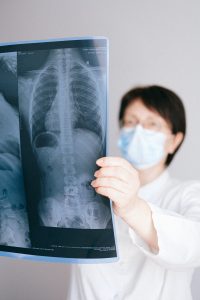Spanish Level 2- Activities Designed for Online Instruction
🦵 Spanish Level 2, Activity 12: Partes del Cuerpo / Parts of the Body (Online)

Products: Hospitals, healthcare
Practices: Receiving medical care, giving recommendations
Perspectives: The importance of healthcare
NCSSFL-ACTFL World-Readiness Standards:
- Standard 1.1 – Students engage in conversations, provide and obtain information, express feelings
and emotions, and exchange opinions. - Standard 1.2 – Students understand and interpret spoken and written Spanish on a variety of topics.
- Standard 1.3 – Students present information, concepts, and ideas in Spanish to an audience of
listeners or readers on a variety of topics.
Idaho Content Standards for World Languages:
- COMM 1.1 – Interact and negotiate meaning (spoken, signed, written conversation) to share
information, reactions, feelings, and opinions - COMM 2.1 – Understand, interpret, and analyze what is heard, read, or viewed on a variety of topics
- COMM 3.1 – Present information, concepts, and ideas to inform, explain, persuade, and narrate on a
variety of topics using appropriate media in the target language. - CONN 1.2 – Relate information studied in other subjects to the target language and culture.
NCSSFL-ACTFL Can-Do Statements:
- I can identify and describe parts of the body.
- I can listen to and understand commands.
- I can use clues to help others understand.
Materials Needed
Would you like to make changes to the materials?
Access the template(s) below:
- Heads Up Cards (Canva Template, free account required)
- Patient and doctor cards
Need help with customizing the templates? View this video for help.
Warm-Up
- Open the slideshow and begin by introducing the Can-Dos for today’s activity. Send students the link to the student slideshow.
Hola, ¿cómo están? Estoy ____. Vamos a empezar el lab de hoy con los can-do statements.
Hoy vamos a jugar Taboo virtual. Cada uno va a recibir el link con el slideshow. - Each student will choose a picture from the slide with a picture of a vocabulary word on it. Students will take turns describing the picture in their slide, and the next person will guess the vocabulary word. Remind students not to look at the slides until it is their turn.
Para el calentamiento, van a tomar turnos para describir la foto de la diapositiva. Una persona va a escoger una foto para describirla y también escoger a una persona para que adivine la palabra de vocabulario descrita. No vea las diapositivas antes de tu turno.
Main Activity
- Since students don’t know the subjunctive yet, the instructor will introduce to them “deber” and “tener que” to make recommendations to start the main activity.
Primero, vamos a repasar un poco de vocabulario que vamos a usar para la actividad principal. Por ejemplo: “Debes tomar más agua, o “tienes que comer menos comida chatarra.” - For the main activity, you have two options as an instructor. The first option is to do three examples with them and put them in break-out rooms to do the lab in small groups. The second option is to do it as a whole lab. You will be showing the students pictures of injuries. The students will take turns stating what body part is injured, thinking of a hypothetical scenario that could have caused the injury, and a possible solution to heal the body part.
Para la actividad principal, hay una serie de fotos en los diapositivas. Ustedes deben determinar cuál parte del cuerpo está lastimada (HURT) en la foto. Después, deben practicar con las frases “debes” o “tienes que” para recomendar una solución. Por ejemplo: “En la foto, la mano está lastimada. Debes ir al doctor” - Students should be taking turns identifying the body parts that are hurt and giving recommendations for solutions.
Lo importante es que todos tomen turnos identificando qué parte del cuerpo está mal y que recomiendan. ¡Pueden ayudarse el uno a el otro!
Wrap-up
- Wrap-up questions
- ¿Alguna vez se te rompió un hueso? (Have you ever broken a bone?)
- ¿Tienes algún talento, como tongue-twisting, o eres double-jointed? (Do you have any talents, such as tongue-twisting, or are you double-jointed?)
End of Lab:
- Read Can-Do statements once more and have students evaluate their confidence.
(Use thumbs up/thumbs down or download our student cards) - Encourage students to be honest in their self-evaluation.
- Pay attention, and try to use feedback for future labs!
Relevant NCSSFL-ACTFL Can-Do Statements:
- I can identify and describe parts of the body
- I can listen to and understand commands
- I can use clues to help others understand
Cultural NOtes:
How to Revise or Remix a Pathways Project Activity
Feeling creative? The Pathways Project needs your help in revising and remixing activities for the K-16 language classroom.
Try taking an activity to the next level by:
- Add new content (something you’ve created or another OER source)
- Contribute additional activity suggestions
- Integrate authentic materials such as videos, infographics, photos, etc.
- Suggest how to implement the activity in the classroom
- Customize the content for a specific audience or group of learners (for example, K-5 learners or to differentiate for student’s needs)

